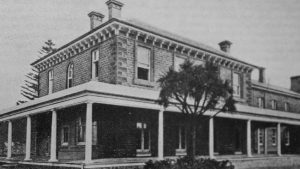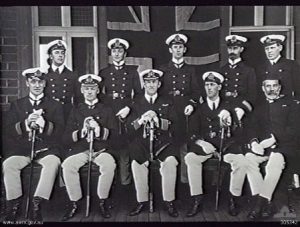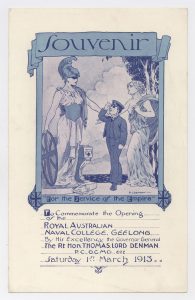- Author
- A.N. Other
- Subjects
- History - general, Ship histories and stories
- Tags
-
- RAN Ships
- None noted.
- Publication
- June 2018 edition of the Naval Historical Review (all rights reserved)
To add confusion to our early naval history there are two residences named Osborne House which both became naval academies. The first of these was in England and the second in Australia. So we shall explore the former English residence before venturing to the latter on more familiar shores.
The original name Osborne is derived from Austerburne, a district to the east of the Medina River in the Isle of Wight. Little is known of the early history but by 1705 the Osborne Estate had passed into the hands of the Blanchford family and Robert Pope Blanchford built a substantial residence there. In 1845 the last of his family, Lady Isabella Blanchford, first leased, and later sold, Osborne with 2,000 acres to Queen Victoria and Prince Albert for £28,000. The Queen wrote:It is impossible to image a prettier spot – we have a charming beach quite to ourselves – we can walk anywhere without being followed or mobbed.
Queen Victoria and her consort Prince Albert disliked Buckingham Palace and rarely stayed overnight. It was mainly used for special occasions and to host receptions. The Court was based at Windsor and in late summer moved to Balmoral and returned to Windsor in September. The Court moved again to Osborne for the winter and Christmas and in February the royal entourage returned to Windsor.
Initially the travel from Windsor to Osborne was by stagecoach as far as Southampton’s Dolphin Hotel where they made a brief stop before making a short trip to the landing stage to board the small HMY Alberta,with the staff embarked in another yacht Elfin,for the brief passage to the Isle of Wight. The more prestigious Royal Yacht Victoria and Albert was considered too large for these domestic duties.
Later on with the advent of rail transport the royal party took a train to a special station at Gosport where the Alberta and Elfin took them to a new wharf which had been constructed, leading directly to the grounds of Osborne House.
The royal family took delight in their seaside home and each year spent as much time as possible there and at Balmoral. Victoria spent a record total of 123 days at Osborne in 1848, when building and planting activity was at its height. The family, accompanied by the Court, established a regular pattern of visits, generally including four main periods at Osborne: in May, part of July and August, and from late November to Christmas, before returning to Windsor.
On 14 December 1861 Prince Albert died from typhoid at Windsor. The widowed Queen, overwhelmed with grief, retreated to Osborne where she remained until March 1862. In her later years the Queen stayed at Osborne for about 100 days each year and she died there on 22 January 1901 at the age of 81.
The death of Queen Victoria left a vacuum for the Osborne estate and much of the land and outbuildings was gradually sold. King Edward VII did not need Osborne, preferring Sandringham. On the day of his coronation the new King wrote: As Osborne is sacred to the memory of the late Queen, it is the King’s wish that…His people shall always have access to the House which must forever be associated with Her beloved name. A committee appointed to propose a suitable use for the residence determined that a convalescent home for officers in part of the house, and the stables used for naval cadets, would be most suitable.
As a result of rapid naval expansion the Royal Naval College Osborne was established in 1903. Boys arrived at the age of 13 and stayed for two years before moving to the Britannia Royal Naval College at Dartmouth, where they completed their studies. Building began in March 1903 and the new facility was opened by King Edward VII the following August.
The first intake was of 72 cadets, but within two years the number had risen to 400, increasing to its maximum of 500 during WWI. Both the future King Edward VIII and his brother King George VI attended as cadets.
With reductions following the armistice the Navy was over-manned and by 1920 the number of cadets at Osborne had fallen to about 50. The next year the college closed and in the 1930s many of the buildings such as dormitories were demolished.
The Edward VII Convalescent Home for officers opened in 1904 within part of the main house. It was run by the house governor, who also managed the royal apart-ments which had been retained. In WWI officers were not allowed home to convalesce as it delayed their return to the Front and many were sent to Osborne. The poet and author Robert Graves and A. A. Milne (of Christopher Robin fame) were both patients. After WWII the facility was transformed into a general nursing home but escalating costs forced its closure in 2000.
Osborne House in Victoria
Osborne House was built in 1858 for local pastoralist Robert Muirhead, who named the mansion after Queen Victoria’s residence on the Isle of Wight. Muirhead commissioned the leading Melbourne architects Webb and Taylor to undertake work on the grand bluestone buildings. He lived at the house until his death in 1862, with the house being sold the following year, after the death of his wife. The house was leased for a number of years, but was finally sold to James Francis Maguire in 1878.

In 1900 the State Government purchased the house as a country residence for the Governor of Victoria, although it was never used as such. The Geelong Harbour Trust purchased the house for £6000 in 1905. A dining room and seven bedrooms were added in 1910, the Trust using Osborne House as a guest house for a number of years. In 1911 the Trust was prepared to offer the house as a gift to the nation providing it was used for Defence purposes, but the proposal was not accepted at that time.

As part of the overall Henderson Plan1the Royal Australian Navy was to have its own fleet and facilities which were to complement Imperial naval forces. As Australian officers and men should be interchangeable with those of the Royal Navy it was necessary that the training provided should be on similar lines to that in Great Britain. Measures were quickly taken for the training of seamen with the Commonwealth acquiring the Sydney-based NSW reformatory training ship Sobraon. She was commissioned as HMAS Tingira on 25 April 1912 and, remarkably, started naval training a few weeks later on 01 June 1912 with an initial intake of 86 boys. The search for a new officer training school took much longer with numerous sites being inspected, but eventually a political decision was made to establish a new facility on Commonwealth land at Jervis Bay.
As this would take some time to implement, a lease was taken over Osborne House as a temporary naval college on 01 January 1913. It had been proposed as a permanent location for the naval college as it was close to rail transport and had safe anchorage in Corio Bay, but the institution was short-lived, being relocated to HMAS Creswell at Jervis Bay in 1915.

Staffing of the new college commenced in April 1912 when retired Royal Naval Lieutenant Duncan Grant was appointed as Executive Officer. Grant, who was a physical training instructor by specialisation, had been on the staff of both Osborne and Dartmouth colleges. Although quite deaf, this tall and athletic officer was keen and energetic and displayed outstanding leadership capabilities. The following month Captain Bertram Mordaunt Chambers arrived from England on loan from the Royal Navy to take up his position as Second Naval Member of the newly established Australian Naval Board. On 01 July 1912 HMS Encounter was transferred to the RAN as a training ship. This was initially a temporary measure while the cruiser Brisbane was building at Cockatoo Island Dockyard. Captain Chambers took command of Encounter, while at the same time superintending the establishment of the new naval college.
On 01 October 1912 Mr. Frederick George Brown was appointed the first Director of Studies and the Reverend William Hall as Chaplain and Naval Instructor. Brown was born in England where he gained first class honours in mathematics from London University before completing further studies at Adelaide where he gained a BSc. He was the first Principal of Perth Modern School before taking up his appointment at the College. Hall, another mathematician, was a scholar from Kings College Cambridge, who after graduation was ordained into the Church of England and later entered the Royal Navy. He was lent to the RAN in 1912. When the college moved to Jervis Bay Mr. Brown resigned and was replaced by the Reverend Hall. Added to this band of quite remarkable men was another stalwart, Frank Burgess Eldridge, who joined as a Naval Instructor in January 1913.
A house adjoining the main residence was acquired as quarters for the Captain Commanding the College and was named St Helens. Some improvements to the main buildings were carried out, including the erection of a block of buildings as quarters for unmarried seamen, two new classrooms, and alterations to the main room to provide a large barrack for cadets. On 01 February 1913 the first class of students entered the newly established Royal Australian Naval College. Twenty-eight 13 year-old boys had been selected from 138 candidates. The college housed the 28 cadets, four petty officers, and 10 seamen, together with the instructors and domestics.
From the inaugural entry, known as the Pioneer class, three members, Sir John Collins, Harold Farncomb and Harry Showers, reached flag rank. Three other cadets from the first entry failed to meet the exacting standards and were discharged before graduation, and sadly Cadet Otto Albert was to die from meningitis at his home when on leave in May 1914.
The college was officially opened by the Governor-General, Lord Thomas Denman, on 01 March 1913 with Prime Minister Andrew Fisher and Rear Admiral Sir William Creswell also present. Their Excellencies and the official party made the journey on board the new Torpedo Boat Destroyer HMAS Warrego,accompanied by her sisters HMA Ships Parramattaand Yarra, and another 200 invited guests arrived by train from Melbourne. The Vice-Regal party was welcomed at the College jetty by Captain Chambers just after two o’clock in the afternoon. The guard of honour was provided by a 200 strong detachment of the Geelong Naval Reserves. The Cadet-Midshipmen who had been drawn up on the lawn were then inspected.
Before the RAN Naval College had accepted its first students the Chaplain and Naval Instructor, the Reverend Hall, had been in correspondence with the Commander-in-Chief of the Australia Station, Admiral Sir George Fowler King-Hall. To which the Admiral responded:
Your letter raises an important question to which I feel I can scarcely attempt to do justice at the present time. My opinion is that the teaching of naval history at the College should have the following objects:
- To put into the boys the spirit of the British Navy.
- To give an outline of modern naval history showing how our present system of naval stations all over the world has been built-up, and the use and object of these stations.
- To teach the influences that naval power has had on the history of the maritime power of the world.
The writer then elaborates on the above points before concluding as follows:You must understand that this is hurriedly expressed opinion on a great subject, and a subject I am greatly interested in. I think we should go for broad treatment. I should be glad to discuss this question with you and Mr. Eldridge if it could be arranged.
We assume this may have been the impetus to a visit to the College by the Commander-in-Chief in August 1913. At this time the Admiral was a guest of the Governor-General, Lord Denham, whose official residence was then in Melbourne, also the seat of the Federal Parliament. The following extract is from a transcript of the C-in-C’s personal diary.
Monday 04 August 1913. Motored 45 miles to Geelong with Creswell, Drummond and Flag Lt. Visited RAN College, was extremely pleased at everything I saw. The Cadets most smart and intelligent, only been there five months, but quite equal to the Cadets at Osborne (UK) in every way, good manners and much due to Grant the Executive Officer and Captain Chambers. I gave them an address, which I felt was good, and also afterwards spoke to the Instructors and men. Lunched with the Chambers, and returned by 4 pm on a shocking road and bitterly cold. Fortunately I had the GG’s fur coat on.
There were only two college entries at Osborne House, the inaugural class of 1913 and the subsequent 1914 class of 31 students. In January 1915 students from these intakes moved to Jervis Bay to complete their studies and join up with another 31 students of the 1915 intake who came directly to Jervis Bay. The new college at Jervis Bay, HMAS Creswell, officially opened on 10 February 1915.
During WWI Osborne House was used as a naval and military convalescent hospital, and between 1919 and 1924 was used as a base by the RAN Submarine Service for the J-class submarines. The Geelong Harbour Trust regained control in 1929, with a caretaker being the only resident. In 1937 the Shire of Corio Council purchased the property for use as shire offices. In 1939 the Department of Defence took over the premises to use as an army training centre.
In 1945 the Shire of Corio regained control of Osborne House to use as its offices. The shire purchased adjoining land in 1947, and remodelled the offices in 1966. The amalgamation of the shire into the City of Greater Geelong in 1995 saw the house lie empty for a time. Today the stables house the Geelong Maritime Museum and the Geelong Memorial Brass Band, the house itself is home to various community groups.
In mid-2017 the museum and other tenants at Osborne House had to relocate to other facilities and the main building is closed until further notice. This was brought about by the discovery of an unacceptably high level of mould which is widespread throughout the facility, making the buildings uninhabitable owing to health concerns. As yet the time and cost of extensive remedial work has not been determined.
Summary
The two Osborne Houses are of interest to researchers into our naval history. By virtual of scale the former had much greater influence overall on naval officer training but only a small proportion of graduates would have served directly or indirectly in the RAN. In the latter case of Osborne House at Corio Bay, the first 59 cadets to enter the RAN started their training here but none graduated directly from Osborne House, they had to wait to complete their training at Jervis Bay before graduation from that establishment.
Notes:
Admiral Sir Reginald Henderson was engaged by the Commonwealth Government to advise on the future composition of the RAN and associated infrastructure – his report was received in March 1911.




